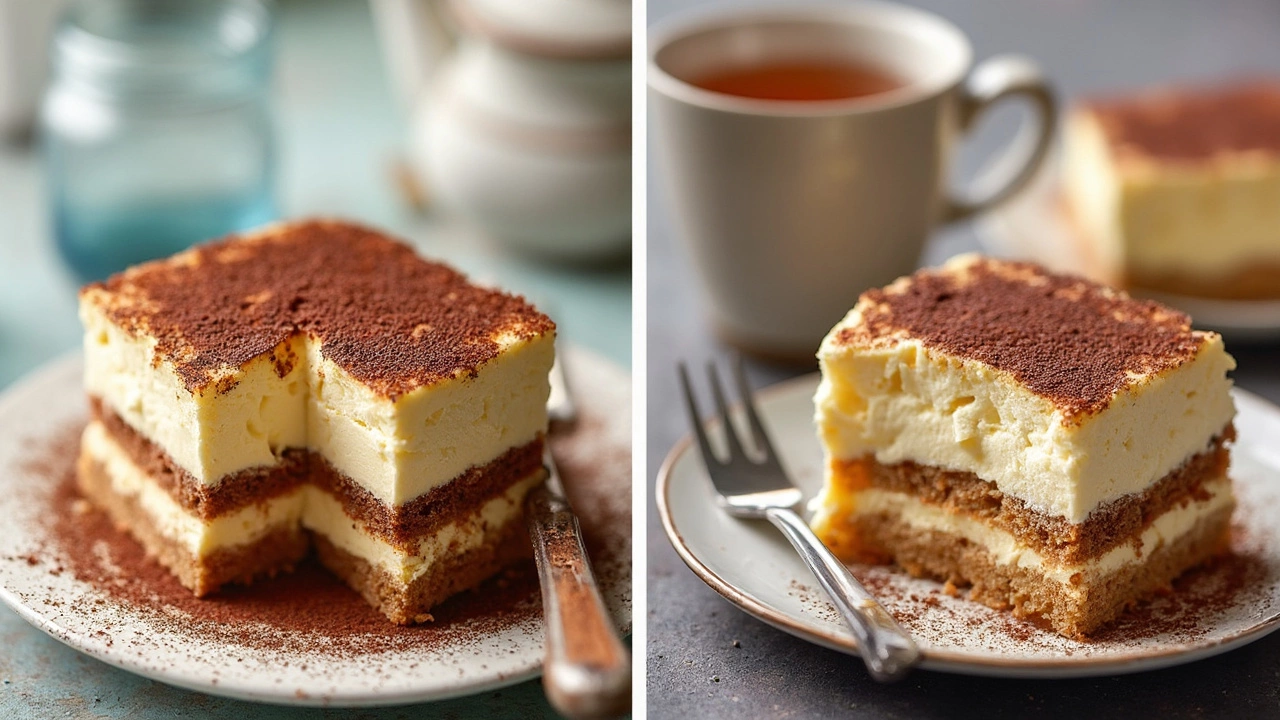
Ever stood in the dairy aisle holding mascarpone, ricotta, and cream cheese, completely lost on which one actually works best for tiramisu? You're not the only one wondering. I mean, mascarpone is the classic pick, but honestly, it’s expensive and sometimes sold out faster than Tamsin’s favorite ice cream.
If you want a tiramisu that tastes just right but without the mascarpone price tag, you’re probably eyeing those big tubs of ricotta cream or good ol’ cream cheese. But which swap keeps your dessert creamy, light, and never weirdly dense or tangy for the wrong reasons?
I’ve tried both—sometimes out of curiosity but honestly, mostly because I forgot to buy mascarpone or it’s nowhere to be found. Let’s bust the myths, share what actually works, and get you one step closer to that dream tiramisu without any expensive or hard-to-find ingredients.
- Why Not Just Use Mascarpone?
- Ricotta Cream: The Lighter Twist
- Cream Cheese: Rich and Tangy
- Choosing Your Winner for Tiramisu
Why Not Just Use Mascarpone?
So, why do all the classic tiramisu recipes call for mascarpone? There’s a good reason: mascarpone is creamy, rich, but not too heavy, and has a super mild flavor that lets the coffee and cocoa do their thing. It’s basically the gold standard for tiramisu filling.
But mascarpone hasn’t always been so easy to find or affordable. Prices shot up by almost 30% in the past three years—yep, check your local prices. Plus, if you live outside of Italy or Europe, sometimes it’s a total guessing game whether the grocery store even has it in stock.
If you want to talk real numbers, check this out:
| Cheese | Average Price (per 250g) | Availability in US grocery stores |
|---|---|---|
| Mascarpone | $5.99 | About 60% |
| Cream Cheese | $2.99 | Almost 100% |
| Ricotta | $3.49 | 97% |
This means mascarpone is not only pricier but also a bit like finding a unicorn—yes, magical, but not always possible when you actually want to make a tiramisu on a random weeknight.
The other thing? Not all mascarpone brands taste the same. Some are a little sour, some too runny, and a few honestly not worth the splurge. For busy parents or anyone cooking from a basic supermarket, finding the perfect mascarpone isn’t always realistic. That’s why ricotta cream and cream cheese end up in the running. Let’s see which one steps up next.
Ricotta Cream: The Lighter Twist
So, ricotta cream pops up as a top contender when you can't get mascarpone for your tiramisu. Here's what you really need to know: ricotta is made from whey, giving it a less fatty, fresher texture than cream cheese or mascarpone. That means your filling will be lighter, almost fluffy, and less likely to feel heavy or greasy after a big slice.
The taste is pretty mild, almost milk-like. It doesn’t have that signature tang you get with cream cheese. When you use ricotta, your tiramisu ends up with a cleaner, more gentle flavor—just watch out if you grab a grainy tub at the store. Grainy ricotta can totally ruin the silky finish you're after. The trick? Always blend your ricotta with a hand mixer, or even push it through a fine sieve, if you want a smoother result.
Another plus: ricotta is usually lower in fat and calories, so if you’re thinking about making a "lighter" dessert, this is your friend. But be careful—ricotta can also be a bit watery. Always drain the extra liquid (called whey) using a cheesecloth or a few paper towels pressed in a fine strainer. This little step saves your tiramisu from turning into a soggy mess in the fridge.
Some home bakers actually mix ricotta with a little whipped cream to mimic that airy mascarpone texture. I’ve tried it, and it definitely gives you a creamier mouthfeel without tasting "diet." But don’t go wild—too much whipped cream and you lose the structure of your filling.
- Use whole milk ricotta for best texture.
- Drain off excess liquid so your dessert sets right.
- If your ricotta is grainy, beat it well or strain it smooth.
- Consider blending in a spoonful or two of whipped cream for extra creaminess.
Bottom line? Ricotta cream gets you close to the real deal, especially if you hate that heavy feeling after dessert. As long as you prep it right, nobody at the table will even notice the swap.

Cream Cheese: Rich and Tangy
Cream cheese pops up everywhere because it’s cheap, easy to find, and packs a decent punch in desserts. Plenty of home bakers, especially in the US, use it as a swap when mascarpone costs too much or just isn’t there. But here’s the deal—cream cheese brings a unique taste and texture, and it’s impossible to ignore that tangy kick.
If you go for cream cheese in your tiramisu, your filling will be noticeably denser and a bit heavier. It holds shape really well (no floppy slices!), but there’s a slight tartness. Not bad, but it’s a step away from the classic Italian vibe, where the filling should be mellow and sweet. The fat content is also a little lower than mascarpone, so the creaminess isn’t quite the same, but you’re still in rich dessert territory.
Here’s how cream cheese lines up, side by side with mascarpone and ricotta:
| Property | Cream Cheese | Mascarpone | Ricotta Cream |
|---|---|---|---|
| Fat content (per 100g) | ~34g | ~44g | ~13g |
| Texture | Dense, smooth | Silky, spreadable | Light, grainy |
| Taste | Tangy, slightly salty | Mild, sweet | Mild, milky |
Getting the best out of cream cheese in tiramisu isn’t hard, but a few tweaks help:
- Let it soften fully before mixing. You want it smooth, with zero lumps.
- Cut down on added sugar because cream cheese already has a bit of sharpness. Taste as you mix.
- Mix in a spoonful of heavy cream or whipped cream to lighten the texture if it feels too stiff.
- Remember, for some folks, the tang is perfect. For others—especially purists—maybe not, but you’ll never get a slice that falls apart.
Cream cheese may not fool an Italian nonna, but honestly? No one's turning down a well-chilled, creamy slice at the end of a long week. If mascarpone is out of reach, cream cheese gets the job done—just don’t expect it to taste exactly the same.
Choosing Your Winner for Tiramisu
If you’re deciding between ricotta cream and cream cheese for your tiramisu, what you really want to know is which option comes closest to the real thing. For classic tiramisu, mascarpone is used for its mild flavor and creaminess. When you swap it out, you want a cheese that blends smoothly, doesn’t overpower the dessert, and gives you that dreamy, scoopable texture.
Here’s what happens in real kitchens:
- Cream cheese: This is rich and tangy—think of your favorite cheesecake. It’s dense and will make your tiramisu taste heavier, with a slight tang. If you use cream cheese, soften it first and whip it really well with cream to mellow out the tang. Don’t expect it to fool traditionalists, but honestly, kids and people who like a thicker, almost frosting-like texture won’t mind.
- Ricotta cream: This is lighter and fresher. Good-quality ricotta (not the grainy, watery type) can make the dessert fluffy yet rich. Drain extra liquid before using, or blitz it in a blender to smooth out those curds. Ricotta’s flavor is mild, so it lets the coffee and cocoa shine. If you want a lighter tiramisu, ricotta cream wins—especially for warm days or after a heavy dinner.
I’ve found that a lot of folks actually mix the two—half ricotta, half cream cheese—to get the best of both worlds. Want your tiramisu even closer to authentic? Add a bit of heavy cream or whipped cream when using either substitute. It stops the mixture from being too dense or too grainy. My family’s favorite ratio: 1 part ricotta, 1 part cream cheese, 2 parts whipped cream. Seriously, it works wonders in a pinch.
Bottom line: if you want a tiramisu that tastes classic and feels light, ricotta cream is usually the better bet. If you need a stronger taste and denser bite, go for cream cheese, but tweak it with cream. Just don’t stress—whichever you choose, tiramisu is still going to be a crowd-pleaser every single time.












Write a comment